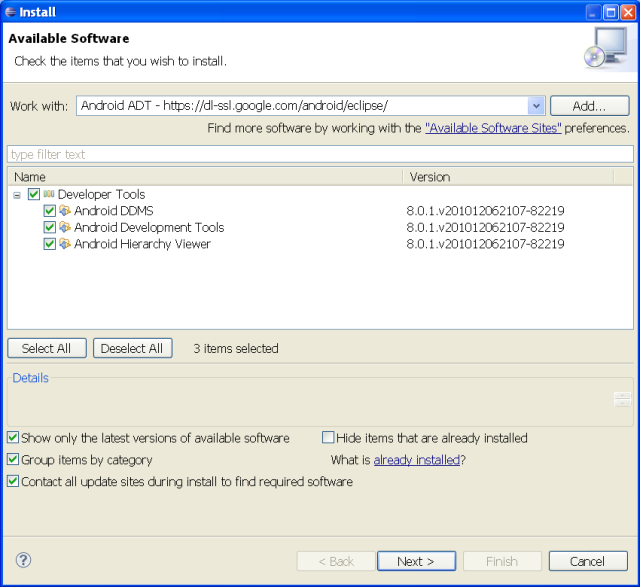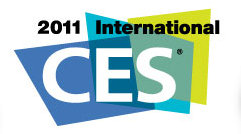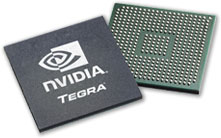You’ll find the full details for installing Android SDK at http://developer.android.com/sdk/installing.html. The purpose of this blog entry is to summarize what I had to do to install Android development environment (Android 2.3 SDK (Gingerbread)) on Windows XP. Before installing the Android SDK per se, you’ll need to install some set of tools used by the SDK. Here are the steps to setup your Windows XP computer for Android development: 1. Install Java Developer Kit (JDK) You need to go to http://www.oracle.com/technetwork/java/javase/downloads/index.html, select your OS (e.g. Linux, Windows, MAC…) and the file you want to download. I selected Java Platform (JDK), then downloaded Java SE Development Kit 6u23. I got the jdk-6u23-windows-i586.exe which I installed in the default directory, i.e. C:\Program Files\Java\jdk1.6.0_23). 2. Install Eclipse Classic Then you’ll need to install Eclipse, and open source IDE. Several versions are available at http://www.eclipse.org/downloads/, but since Google recommends Eclipse Classic, I just download […]
Near Field Communication (NFC) Introduction and Software Development
Android 2.3 features near field communication (NFC) in order to allow payment through your phone as it is already implemented in Japan with FeliCa (Felicity Card), a contactless RFID smart card system from Sony, direct communication between NFC devices, RFID reader, etc… NFC is already supported in Samsung / Google Nexus S. In this blog post, we’ll see what near field communication is, which hardware is needed and what needs to be done at the software level (driver and NFC stack). What is Near Field Communication ? Extract from Wikipedia: Near Field Communication or NFC, is a short-range high frequency wireless communication technology which enables the exchange of data between devices over about a 10 centimeter (around 4 inches) distance. The technology is a simple extension of the ISO/IEC 14443 proximity-card standard (proximity card, RFID) that combines the interface of a smartcard and a reader into a single device. An NFC […]
CES 2011 Main Attractions
CES 2011 will be held in Las Vegas 6-9 January 2011 featuring 2700 exhibitors, including manufacturers and service providers for the audio, digital imaging, home theater, wireless, content and gaming markets. Here are what may be the main attractions to look for at the event: Lots of Tablets: Motorola is expected to demo Android 3.0 (Honeycomb) with a 10″ tablet based on NVidia Tegra 2 and announcement about Samsung Galaxy Tab 2 (probably using the Tegra 2 as well) . Here’s a list of companies that will exhibit their tablets at CES 2011: Acer – 7″/10″ Tablets running Android and Windows 7 Archos – Archos Gen 8 Devices: Archos 28/32/43/70/101 running Android Asus – Eee Pad running Windows 7 and Android (March 2011 release) Creative – ZiiO Pure Wireless Entertainment Tablets running Android. Dell – 7″ Dell Streak running Android. Entourage – Dual screen tablet (similar to the Kno) called […]
Android Remote Control App for Google TV
Google has just released a new app in Android Marketplace to be able to control your Google TV compatible set-top box or TV with your Android Smartphone. It just looks like a normal remote control, but you’ll also be able to use voice recognition to select your channel and videos, select a video on your phone to be played on the TV, etc… I wonder if this will engender family or friend’s wars since several Android phones can be used with one TV. Oh.. and also Google is offering 100 46″ Sony Google TV to the best videos. Deadline for submissions 22-12-2010, so it will end later today. Anyway, have a look at Google TV Remote App video below: Jean-Luc Aufranc (CNXSoft)Jean-Luc started CNX Software in 2010 as a part-time endeavor, before quitting his job as a software engineering manager, and starting to write daily news, and reviews full time […]
Resources for NVidia Tegra 2
NVidia Tegra 2 is currently one of the most powerful processor used in smartphones and tablets such as the upcoming LG Optimus 2X smartphone or the new version of Samsung Galaxy Tab. NVidia describes the processor as follows: NVIDIA® Tegra™ 2 is the world’s most advanced mobile processor, featuring the world’s first mobile dual-core CPU for up to 2x faster Web browsing; the world’s only ultra-low power (ULP) NVIDIA® GeForce® GPU for up to 5x faster gaming; and the world’s first mobile 1080p HD video processor for flawless HD video conferencing and playback. Get never-before-seen experiences on a mobile device with NVIDIA Tegra. NVidia Tegra 2 is based on a dual core Cortex A9 running up to 1GHz, supports 32-bit DDR2 RAM and features NVidia Geforce GPU with OpenGL ES 2.0 support. Contrary to many other companies finding the development kit, documentations and tools is straightforward. Once you get to […]
LG Optimus 2X Teaser Video – LG SU660 – LG P990
As you probably know LG announced their Optimus 2X smartphone based on Nvidia Tegra 2 earlier this week. I’ve just come across a Korean website showing LG teaser video/advertisement. Watch it below. Jean-Luc Aufranc (CNXSoft)Jean-Luc started CNX Software in 2010 as a part-time endeavor, before quitting his job as a software engineering manager, and starting to write daily news, and reviews full time later in 2011. www.cnx-software.com
An Update for Qualcomm Augmented Reality SDK and Extension for Unity is Available
Qualcomm has just released their new Augmented Reality SDK with Unity Support: We encourage you to upgrade immediately to the newest version of Qualcomm’s augmented reality (AR) software development kit (SDK) and Extension for Unity released today, Friday, December 17. This version includes support for virtual buttons and multi-image targets and improved stability for both the SDK and the AR Extension. Additionally, we are pleased to announce that the Qualcomm AR SDK now supports several new devices including the Dell Streak, HTC Desire HD, HTC Desire Z, T-Mobile G2 by HTC, HTC myTouch 4G, Motorola DROID 2, Motorola DROID X, and Sony Ericsson Xperia X10. Download the latest Qualcomm SDK and Extension for Unity at developer.qualcomm.com/ar AR SDK version 0.10.0 (BETA2) Changelog: Added support for multi-image target reconfiguration (add / remove / reconfigure parts on the fly) Added support for virtual button reconfiguration (add / remove / reconfigure buttons on […]
Embedded Systems Hardware & Software Trends for 2011
VDC Research – a US company specialized in technology market intelligence – recently released two reports about embedded systems trends for 2011. The first report focuses on hardware and the second on software. The first report entitled “Top 10 trends for the embedded hardware and systems market in 2011” listed the following trends: COMs gain traction as time-to-market accelerators for OEMs By combining COM express modules with off-the-shelf COMs, suppliers are able to offer several different configurations of CPU boards and leverage COMs’ interchangeable characteristics. CPU vendors can thus offer a fairly wide range of boards without incurring high design and inventory carrying costs. PC/104 module family under pressure Although VDC data projects the PC/104 family will experience a single-digit rebound from the low points of the recent recession, vendors will have to commit resources to develop newer strategies in order for this technology to remain viable. Otherwise, the recovery […]







